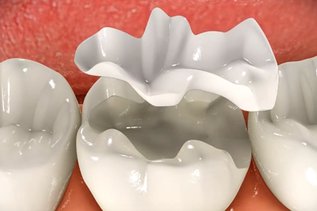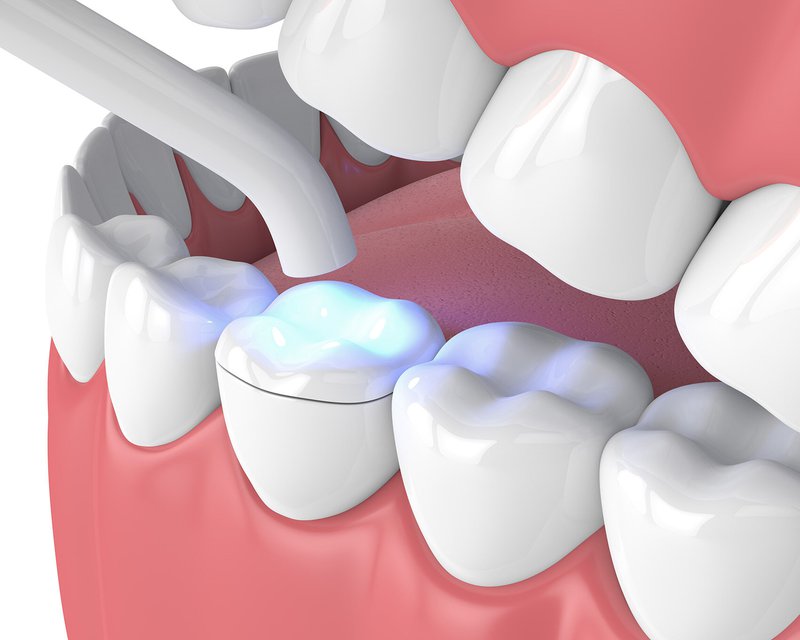
Porcelain Onlays: Definition and Purpose
Porcelain onlays are an integral part of modern dentistry, offering a versatile and effective solution for restoring damaged or decayed teeth while preserving as much natural tooth structure as possible.
Porcelain onlays, also known as partial crowns, are dental restorations designed to repair and strengthen teeth that have been affected by decay, damage, or other dental issues. Unlike traditional fillings that are placed directly into a cavity, onlays are custom-made in a dental laboratory and then bonded onto the tooth surface, covering a larger area of damage while preserving the healthy tooth structure.
Before delving into the specifics of porcelain onlays, it's essential to grasp their definition and purpose. This knowledge not only empowers patients to make informed decisions about their dental care, but also enables dental professionals to recommend the most suitable treatment options based on individual needs and circumstances.
What Are Porcelain Onlays?
Porcelain onlays are dental restorations made from high-quality ceramic materials that closely resemble natural tooth enamel in both appearance and function. They are meticulously crafted to match the shape, size, and colour of the patient's natural teeth, ensuring a seamless and aesthetically pleasing result.
Porcelain onlays differ from other dental restorations, such as fillings and crowns, in their design and application. While fillings are typically used to fill small cavities, and crowns encase the entire visible portion of a tooth, onlays are custom-fitted to cover only the damaged or decayed area of a tooth, preserving the surrounding healthy tooth structure.
Composition and Characteristics
Porcelain onlays are renowned for their exceptional strength, durability, and aesthetic appeal. They are fabricated using advanced dental ceramics that mimic the natural translucency and colour variation of enamel, resulting in restorations that blend seamlessly with your smile.
The materials used in porcelain onlays may vary depending on your specific needs and the preferences of your dentist. Commonly used materials include porcelain, ceramic, and composite resin, each offering unique advantages in terms of strength, durability, and aesthetics.
Porcelain onlays are prized for their remarkable strength and durability, allowing them to withstand the rigours of daily chewing and biting forces. Additionally, their lifelike appearance and colour-matching capabilities make them virtually indistinguishable from natural teeth, ensuring seamless integration.
Purpose of Porcelain Onlays
Porcelain onlays serve multiple purposes in restorative dentistry, ranging from restoring damaged or decayed teeth to strengthening and reinforcing weakened tooth structure while preserving as much natural tooth material as possible.
Restoring Damaged or Decayed Teeth
One of the primary purposes of porcelain onlays is to restore teeth that have been compromised by decay, fractures, or other forms of damage.
By replacing the damaged or decayed portion of the tooth with a custom-fitted porcelain onlay, dentists can restore both the form and function of the tooth, effectively resolving underlying dental issues while preserving the surrounding healthy tooth structure.
Strengthening and Reinforcing Tooth Structure
In addition to restoring damaged teeth, porcelain onlays are also used to strengthen and reinforce weakened tooth structure. By bonding securely to the remaining tooth surface, onlays provide added support and stability, reducing the risk of further damage or fracture.
Preserving Natural Tooth Structure
One of the most significant advantages of porcelain onlays is their ability to preserve as much natural tooth structure as possible.
Unlike traditional crowns, which require extensive tooth preparation and removal of healthy enamel, onlays only cover the damaged or decayed portion of the tooth, leaving the rest of the tooth intact. This preservation of natural tooth structure helps maintain the strength and integrity of the tooth, minimizing the need for more invasive treatments in the future.
Indications for Porcelain Onlays
Porcelain onlays are recommended in a variety of dental situations where preserving natural tooth structure is paramount. Some common indications for porcelain onlays include:
- Large cavities or areas of decay that cannot be adequately addressed with traditional fillings.
- Fractured or damaged teeth that require reinforcement and restoration.
- Teeth with existing fillings that need to be replaced or upgraded for improved longevity and aesthetics.
- Teeth with cosmetic imperfections, such as discolouration or irregularities, that can be corrected with the placement of porcelain onlays.
Advantages of Porcelain Onlays
One of the primary advantages of porcelain onlays is their conservative approach to tooth restoration. Unlike crowns, which require extensive tooth preparation and removal of healthy enamel, onlays only cover the damaged or decayed portion of the tooth, leaving the rest of the tooth intact. This preservation of natural tooth structure not only maintains the strength and integrity of the tooth, but also reduces your risk of future complications.
Porcelain onlays are renowned for their lifelike appearance and natural-looking results. Additionally, porcelain onlays can be custom-fabricated to match the shape, size, and shade of your natural teeth.

Procedure for Porcelain Onlays
The process of what is a tooth onlay typically involves several steps, beginning with an initial consultation and examination and culminating in the bonding and fitting of the custom-made restorations.
Initial Consultation and Examination
The first step in the porcelain onlay procedure is an initial consultation with a dentist. During this appointment, the dentist will evaluate your oral health and discuss your treatment goals and concerns.
X-rays and other diagnostic imaging may be taken to assess the extent of tooth damage or decay and determine the suitability of porcelain onlays as a treatment option.
Tooth Preparation
Once the decision to proceed with porcelain onlays has been made, the tooth or teeth receiving the restorations will be prepared. This involves removing any decayed or damaged tooth structure and shaping the remaining tooth surface to accommodate the onlay.
Unlike crowns, which require significant tooth reduction, onlays require minimal tooth preparation, preserving as much natural tooth structure as possible.
Bonding and Fitting of Porcelain Onlays
After the tooth has been prepared, impressions or digital scans of the tooth are taken to create custom-fitted porcelain onlays. These restorations are fabricated in a dental laboratory by skilled technicians using advanced CAD/CAM technology or traditional methods.
Once the onlays have been fabricated, they are carefully bonded onto the prepared tooth surface using dental adhesive, ensuring a secure and long-lasting fit.
Customization and Aesthetics
One of the key benefits of what is a porcelain onlay is its ability to be customized to match natural teeth seamlessly. Dentists work closely with patients to select the appropriate shape, size, and shade of the onlays, ensuring a perfect aesthetic match with the surrounding dentition.
Additionally, special attention is paid to the contours and surface texture of the onlays to achieve a natural-looking result.
Porcelain onlays can be customized in terms of shape, size, and shade to achieve optimal aesthetic results. Dentists may use shade guides and digital imaging technology to match the colour of the onlays to your natural teeth, ensuring seamless integration with the surrounding dentition.
The ultimate goal of porcelain onlays is to achieve a seamless integration with the patient's natural teeth, both in terms of appearance and function. By carefully customizing the shape, size, and shade of the onlays and using advanced bonding techniques, dentists can create restorations that are virtually indistinguishable from natural tooth enamel.

Aftercare and Maintenance
Proper care and maintenance are essential for ensuring the longevity and success of porcelain onlays.
- Maintain good oral hygiene: Brushing and flossing regularly are essential for keeping porcelain onlays and the surrounding teeth clean and free of plaque and tartar buildup.
- Use non-abrasive dental products: Patients should use a soft-bristled toothbrush and non-abrasive toothpaste to avoid scratching or damaging the surface of the onlays.
- Avoid excessive force: Patients should avoid habits such as biting on hard objects or using teeth as tools, as these can increase the risk of chipping or fracturing the onlays.
- Attend regular dental check-ups: Routine dental check-ups and cleanings are essential for monitoring the health of the onlays and detecting any issues early on.
In addition to following good oral hygiene practices at home, patients with porcelain onlays should visit their dentist regularly for check-ups and professional cleanings. During these appointments, the dentist will examine the onlay meaning and the surrounding teeth for any signs of damage, decay, or other issues.
Cost Considerations
The cost of porcelain onlays can vary depending on several factors, including the complexity of the case, the number of onlays needed, and the geographic location of the dental practice.
- Materials: The type of material used for the onlays can affect the cost, with porcelain typically being more expensive than composite resin.
- Laboratory fees: The cost of fabricating custom-fitted porcelain onlays in a dental laboratory may contribute to the overall cost of treatment.
- Dentist's expertise: Fees may vary depending on the experience and skill level of the dentist performing the procedure.
- Insurance coverage: Some dental insurance plans may cover a portion of the cost of porcelain onlays, depending on the individual policy and the reason for treatment.
Onlays in Mapleridge Dentistry
At Mapleridge Dentistry, we are committed to providing high-quality dental care using the latest techniques and materials. Our skilled team of dental professionals has extensive experience in what is a dental onlay and other restorations, ensuring optimal results for our patients.
If you are considering porcelain onlays or would like to learn more about our what is a dental onlay procedure and our restorative dental services, we invite you to schedule a consultation with us. Contact Mapleridge Dentistry today to take the first step toward achieving a healthier, more beautiful smile.

